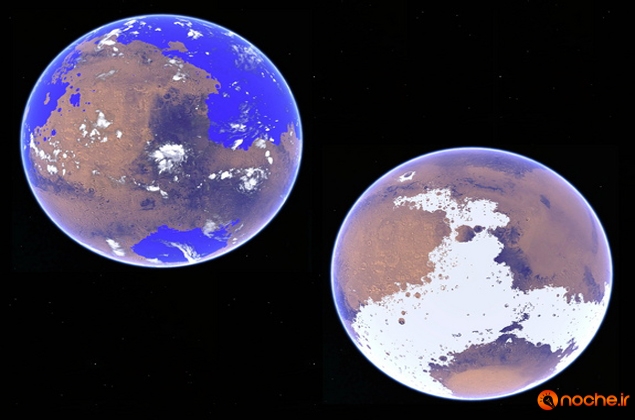Mars may well have had plentiful water billions of years ago—but it was mostly ice, not liquid, a study claims. Researchers say a cold and icy planet billions of years ago better explains water drainage and erosion features seen on the Red Planet today.
Mars may well have had plentiful water billions of years ago—but it was mostly ice, not liquid, a study claims.
Researchers say a cold and icy planet billions of years ago better explains water drainage and erosion features seen on the Red Planet today.
For decades, researchers have debated the climate history of Mars and how the planet’s early climate led to the many water-carved channels seen today.
The idea that 3 to 4 billion years ago Mars was warm, wet and Earth-like with a northern sea—conditions that could have led to life—is generally more popular than that of a frigid, icy planet where water is locked in ice most of the time and life would be hard put to evolve.
In the study, researcher Robin Wordsworth of Harvard University and colleagues used a computer simulation of atmospheric circulation to compare a water cycle on Mars under different scenarios. The model examined an era 3 to 4 billion years ago, during what’s called the late Noachian and early Hesperian periods.
One scenario looked at Mars as a warm and wet planet with an average global temperature of 10 degrees C (50 degrees F) and the other as a cold and icy world with an average global temperature of minus 48 degrees C (minus 54 degrees F).
The study’s authors found that the cold scenario was more likely, based on what’s known of the history of the Sun and the tilt of Mars’ axis at the time. The cold model also did a better job explaining the water erosion features that have been left behind on the Martian surface, they said, and which have puzzled and intrigued scientists since they were first discovered by the Viking orbiters in the 1970s.
A paper on the results has been accepted for publication in the American Geophysical Union’s Journal of Geophysical Research – Planets.
The colder scenario was more straightforward to model, Wordsworth explained, because Mars only gets 43 percent of the solar energy of Earth, and early Mars was lit by a younger Sun believed to have been 25 percent dimmer than it is today.
An extreme tilt of the Martian axis would have pointed the planet’s poles at the Sun and driven polar ice to the equator, where water drainage and erosion features are seen today, the scientists said.
More importantly, they added, under a thicker atmosphere, equatorial highland regions get colder and northern lowland regions get warmer. This is so-called “icy highlands effect” accounts for snow-covered mountain peaks on Earth today. Despite some warming factors—including a thicker atmosphere filled with climate-warming carbon dioxide—Mars still would have been quite cold, Wordsworth said.










